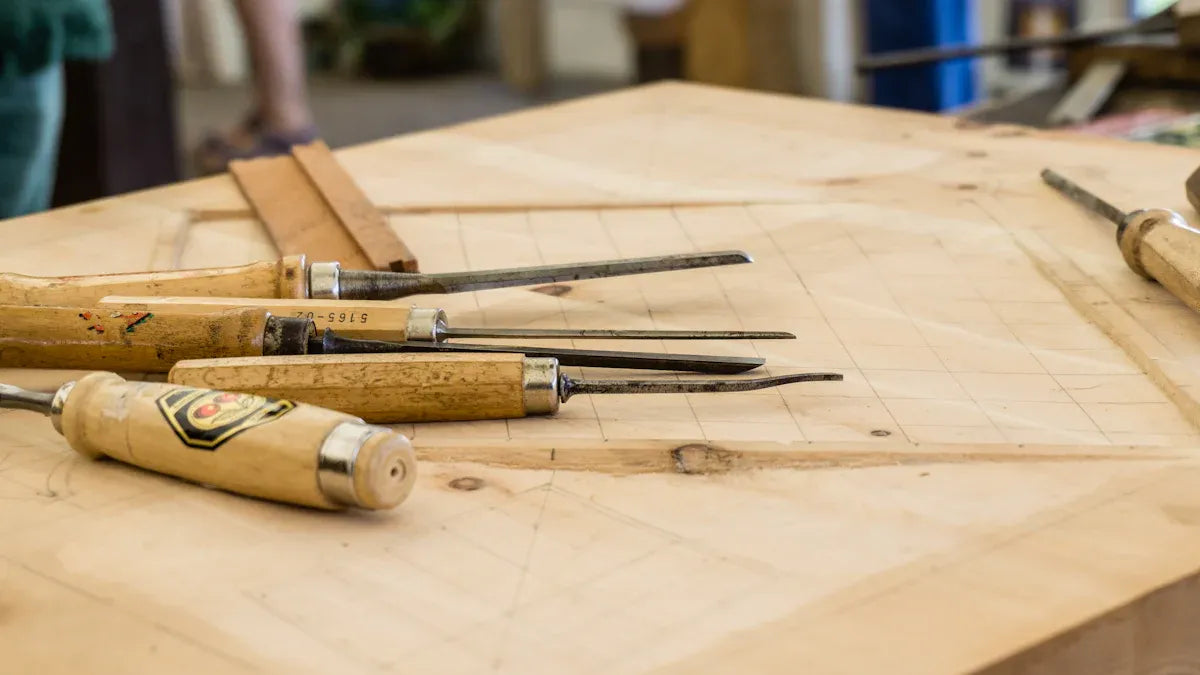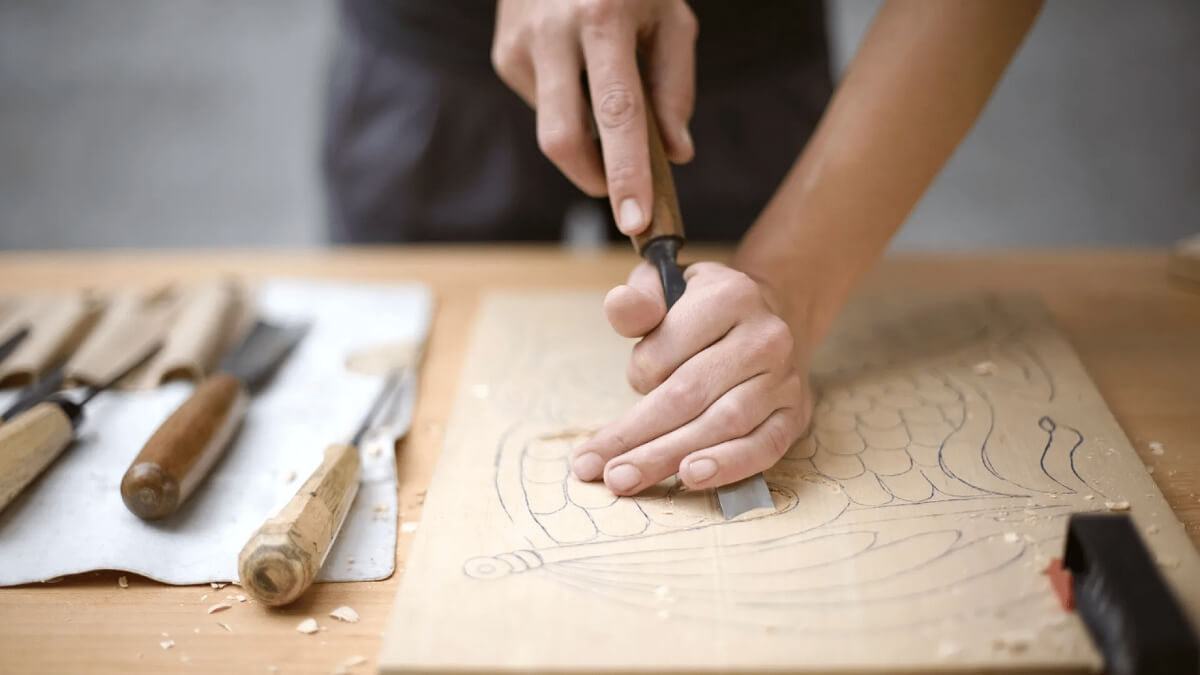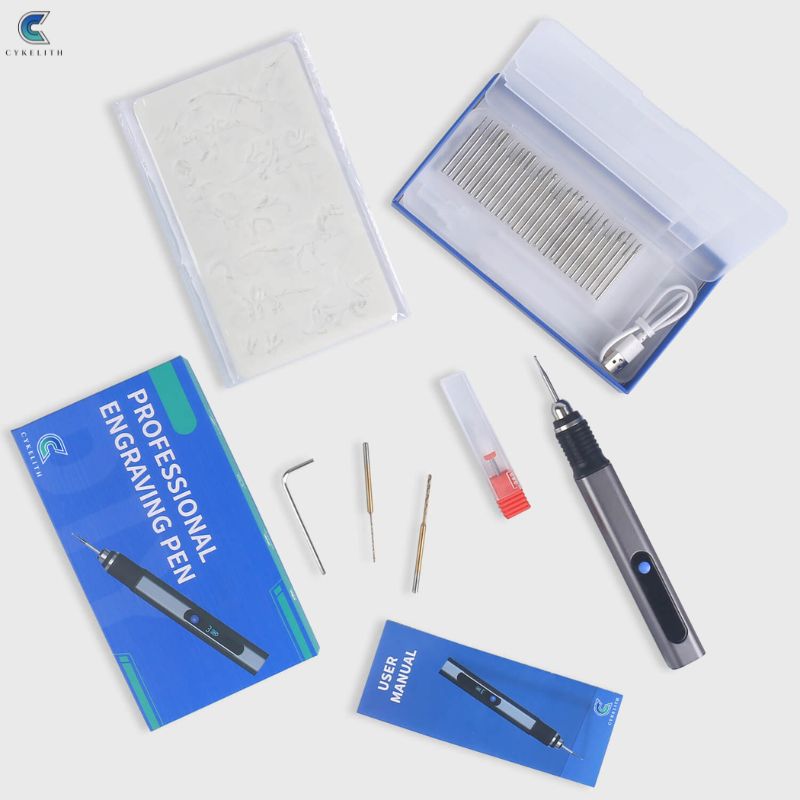Many beginners wonder how long they need to learn wood carving. Most people master the basics in a few weeks and complete simple projects in less than a month. Complex projects often require several months of steady effort. Daily practice accelerates growth and builds confidence. Structured classes or video tutorials help beginners learn wood carving efficiently. Setting personal goals keeps motivation high and makes each step rewarding.
Tip: Celebrate small achievements to make the learning process more enjoyable. For additional guidance, explore beginner wood carving tips.
Key Takeaways
- Most beginners learn wood carving basics in a few weeks and complete simple projects within a month.
- Daily, focused practice builds skills faster and boosts confidence in carving.
- Start with basic shapes and easy projects using soft woods like basswood to build a strong foundation.
- Choose projects that match your skill level and gradually try more challenging designs to keep learning steady.
- Use sharp, well-maintained tools and learn to care for them to improve carving quality and safety.
- Set clear, achievable goals and track your progress with journals or photos to stay motivated.
- Celebrate small wins often to maintain enthusiasm and enjoy the learning journey.
- Join carving clubs, classes, or online communities to get support, feedback, and inspiration.
How Long to Learn Wood Carving
Basics Timeline
Learning the basics of wood carving often takes a few weeks for most beginners. During this period, individuals become familiar with essential tools, safety practices, and basic carving techniques. Many new carvers start by practicing simple cuts and understanding the grain of different woods. Consistent daily practice helps reinforce these foundational skills.
First Projects
Most beginners complete their first simple projects within the first month. These projects might include carving a small spoon, a basic animal figure, or geometric patterns. Early projects focus on straight cuts, shallow reliefs, and smooth finishes. Success in these initial tasks builds confidence and encourages further exploration.
Note: Beginners who follow structured tutorials or join introductory classes often progress faster. For more project ideas, see easy wood carving projects for beginners.
Skill Growth
After mastering the basics, skill growth depends on practice frequency and project complexity. Carvers who dedicate time each day to practice see steady improvement in control and precision. Over several months, they develop the ability to tackle more detailed designs and experiment with new techniques. Tracking progress through photos or a journal helps highlight improvements and areas for further development.
Advanced Skills
Advanced wood carving skills require several months to years of dedicated effort. Carvers at this stage work on intricate sculptures, deep reliefs, or lifelike figures. They refine their technique, learn to sharpen and maintain specialized tools, and experiment with various wood types. Mastery of advanced skills often involves studying under experienced carvers, attending workshops, or participating in carving clubs.
Individual progress varies widely. Some learners advance quickly due to daily practice and focused study, while others take a slower, more relaxed approach. The journey to advanced proficiency in wood carving remains unique for each person. Those who set clear goals and seek feedback from experienced carvers tend to progress more efficiently.
Tip: Regularly challenge yourself with new projects and techniques. This approach keeps the learning process engaging and helps you learn wood carving at a steady pace.
For more information about advancing your skills, visit how to improve your wood carving techniques.
Factors Affecting Progress

Time Spent
The amount of time a person dedicates to wood carving directly influences their progress. Regular practice helps individuals build muscle memory and develop better control over their tools. Many experienced carvers recommend setting aside at least 15 to 30 minutes each day for focused practice. Short, consistent sessions often yield better results than infrequent, lengthy ones. Over time, these daily efforts accumulate, leading to noticeable improvements in technique and confidence.
A beginner who carves only once a week may find it difficult to retain new skills. In contrast, someone who practices daily will likely advance more quickly. Tracking time spent on each project can help individuals identify patterns in their learning and adjust their routines for better results.
Tip: Use a simple calendar or habit tracker to log daily practice. This visual reminder can boost motivation and help maintain consistency.
Project Difficulty
The complexity of chosen projects plays a significant role in skill development. Simple projects, such as carving a basic spoon or a small animal, allow beginners to focus on mastering fundamental techniques. These projects build a strong foundation and help prevent frustration.
As skills improve, individuals can gradually attempt more challenging pieces. Advanced projects, like detailed relief carvings or intricate figurines, require greater patience and precision. Tackling difficult projects too early may lead to mistakes and discouragement. Selecting projects that match current skill levels ensures steady progress and a positive learning experience.
A helpful approach involves alternating between easy and moderately challenging projects. This method reinforces existing skills while introducing new techniques. For more ideas on suitable projects, visit easy wood carving projects for beginners.
Experience Level
Previous experience with woodworking or other crafts can accelerate the learning process. Individuals who have used hand tools before often adapt quickly to wood carving. They may already understand concepts like grain direction, tool safety, and material selection.
Beginners without any prior experience should start with the basics. They benefit from step-by-step guidance and clear instructions. Over time, even those new to crafting can achieve impressive results through patience and practice.
Note: Everyone progresses at a different pace. Comparing progress to others can lead to frustration. Focus on personal growth and celebrate each milestone.
For those interested in structured learning, beginner wood carving tips offer valuable advice for all experience levels.
Tools and Materials
Selecting the right tools and materials shapes the wood carving journey from the very beginning. Quality tools not only make carving easier but also help learners develop proper technique and confidence. Sharp, well-maintained tools allow carvers to focus on skill rather than struggle with resistance or poor results.
A few key habits accelerate progress for beginners:
- Using sharp, well-maintained tools reduces resistance and improves cut quality. This lets the carver concentrate on technique instead of fighting with dull blades.
- Developing the ability to sense resistance forces helps identify when a blade needs sharpening. This habit prevents inefficient work and frustration.
- Listening to the sound of the tool as it moves through wood provides feedback on sharpness and cutting quality. This auditory cue sharpens instincts over time.
- Observing the quality of each cut visually helps maintain precision and avoid poor workmanship.
- Feeling the surface after cutting detects roughness or tearout, guiding adjustments for a smoother finish.
These habits, when practiced regularly, improve efficiency and enhance the quality of each project. As a blade dulls, the energy required to use it increases and the quality of the cut drops. Recognizing when to sharpen tools saves time and prevents wasted effort. Maintaining sharp tools supports faster progress and better results.
Modern carvers benefit from a wide range of specialized tools and high-quality abrasives. Unlike historical woodcarvers, who often relied on a single knife and natural abrasives, today’s learners can choose from gouges, chisels, and sandpapers designed for specific tasks. This access to better tools and materials enables finer finishes and more efficient carving, making the learning curve smoother.
Choosing the right wood also matters. Soft woods like basswood or butternut suit beginners because they carve easily and hold detail well. Hardwoods require more effort and sharper tools, which can challenge new carvers. Starting with quality materials helps learners build skills without unnecessary frustration.
Tip: Invest in a basic set of sharp carving tools and practice regular maintenance. For guidance on tool selection and care, see beginner wood carving tips.
Learn Wood Carving: Step-by-Step

Start Simple
Basic Shapes
Every beginner should start with the fundamentals. Practicing basic shapes helps new carvers develop control and confidence. Simple forms such as cubes, spheres, and cylinders allow individuals to focus on hand positioning and tool movement. These shapes also teach the importance of working with the wood grain.
A recommended approach includes:
- Drawing the shape on the wood before carving.
- Using a straight chisel or carving knife for clean, controlled cuts.
- Rotating the piece to maintain a comfortable angle and avoid mistakes.
- Tip: Beginners who spend time on basic shapes build a strong foundation for more advanced projects. For more guidance, visit beginner wood carving tips.
Easy Projects
After mastering basic shapes, beginners can move on to easy projects. These projects introduce practical skills and provide a sense of accomplishment. Common starter projects include:
- Carving a small spoon
- Shaping a simple animal figure
- Creating geometric patterns or reliefs
Each project should match the carver’s current skill level. Selecting soft woods like basswood or butternut makes the process smoother and more enjoyable. Completing easy projects helps individuals learn wood carving techniques such as smoothing surfaces, adding texture, and finishing edges.
Note: Success with simple projects motivates learners to try more complex designs. For inspiration, check out easy wood carving projects for beginners.
Try New Projects
After mastering basic shapes and completing easy projects, carvers should expand their skills by trying new projects. Exploring different styles and techniques helps individuals grow as artists and keeps the learning process engaging. Each new project introduces unique challenges and opportunities for creative expression.
Carvers can select from a wide range of project ideas. Some popular options include:
- Relief carvings featuring landscapes or animals
- Whittling small figurines or caricatures
- Creating decorative signs with lettering
- Crafting kitchen utensils such as spatulas or butter knives
- Designing ornaments for holidays or special occasions
Trying new projects allows carvers to apply previously learned techniques in fresh contexts. For example, a person who has carved a simple spoon can attempt a more complex utensil with intricate handles or decorative patterns. Each project builds on existing skills and introduces new concepts, such as undercutting, texturing, or finishing with stains and oils.
Tip: Choose projects that stretch current abilities but remain achievable. This approach prevents frustration and encourages steady progress.
Many carvers benefit from following step-by-step guides or video tutorials when starting unfamiliar projects. These resources provide clear instructions and visual demonstrations, making it easier to understand new techniques. For those seeking inspiration, easy wood carving projects for beginners offers a variety of ideas suitable for different skill levels.
Experimenting with different woods also enhances the learning experience. Softwoods like basswood remain ideal for practicing new techniques, while hardwoods such as cherry or walnut introduce new challenges. Each wood type responds differently to carving tools, teaching carvers how to adapt their approach.
Joining a wood carving club or online community can further support growth. Members often share project ideas, offer feedback, and celebrate each other's achievements. These connections foster motivation and provide valuable insights for those who want to learn wood carving more effectively.
Carvers should document each project by taking photos or keeping a journal. This habit helps track progress and highlights improvements over time. Reviewing past projects can reveal patterns in skill development and inspire future creations.
Note: The journey to master wood carving involves continuous learning. Embracing new projects ensures that each step remains exciting and rewarding.
For more guidance on advancing skills and finding new project ideas, visit how to improve your wood carving techniques.
Track Progress

Set Goals
Setting clear, achievable goals helps wood carvers stay focused and motivated. When individuals define specific objectives, they create a roadmap for their learning journey. Goals can range from mastering a new carving technique to completing a particular project within a set timeframe. Breaking larger ambitions into smaller, manageable steps reduces pressure and builds consistency. This approach aligns with research by Anders Ericsson, who found that skill development thrives on focused, repeated practice rather than innate talent.
Carvers benefit from using implementation intentions, such as planning, “When I finish dinner, I’ll carve for 15 minutes.” This strategy increases the likelihood of sticking to routines. Many find that short-term goals, like finishing a simple spoon or learning to sharpen a tool, provide quick wins and keep motivation high.
Tip: Write down goals and review them weekly to track progress and adjust as needed. For more advice on setting effective goals, see beginner wood carving tips.
Journal Learning
Keeping a journal offers a practical way to document progress and reflect on growth. Carvers can record daily practice sessions, note challenges, and celebrate breakthroughs. Journaling helps identify patterns in learning and highlights areas for improvement. Many artists use photos to visually track their work, making it easier to see subtle improvements over time.
A simple journal entry might include:
- Date and duration of practice
- Techniques or projects attempted
- Tools used and any maintenance performed
- Observations about successes and difficulties
This habit not only reinforces learning but also provides a sense of accomplishment. Reviewing past entries can boost confidence and inspire new project ideas. For more on tracking artistic progress, visit how to improve your wood carving techniques.
Celebrate Wins
Recognizing and celebrating small achievements plays a crucial role in maintaining motivation. Research by Teresa Amabile and Steven Kramer shows that even minor progress can increase engagement, creativity, and fulfillment. Small wins trigger dopamine release, which reinforces positive habits and encourages continued effort.
Carvers can celebrate wins in several ways:
- Track progress with visible charts or photos
- Use verbal or mental affirmations after completing a task
- Share successes with friends, family, or online communities
- Reward themselves with a favorite treat or a new tool
- Reflect weekly on what went well
- Note: Celebrating small milestones reduces anxiety, builds resilience, and fosters self-compassion. This positive feedback loop makes it easier to stay committed, even when progress feels slow.
Short art challenges, such as carving a figure in one hour, can also boost creative thinking and confidence. These strategies help carvers enjoy the process and sustain their passion for wood carving. For more tips on staying motivated, explore beginner wood carving tips.
Overcome Challenges
Stay Motivated
Wood carving demands patience and persistence. Many beginners experience slow progress, which can lead to frustration. Setting small, achievable goals helps maintain enthusiasm. Carvers often find motivation by tracking their improvements through photos or journals. Each completed project, no matter how simple, represents a step forward.
A visible progress chart or a collection of finished pieces can serve as a daily reminder of growth. Sharing work with friends, family, or online communities also boosts morale. Positive feedback and encouragement from others reinforce commitment. Some carvers join local clubs or participate in group challenges to stay engaged. These activities foster a sense of belonging and accountability.
Tip: Celebrate every milestone, even minor ones. Recognition of progress fuels long-term motivation.
Handle Mistakes
Mistakes are an inevitable part of the wood carving journey. Many carvers struggle with tool selection and maintenance in the beginning. For example, some beginners do not know how to sharpen gouges or choose the right tool for a specific task. This confusion often leads to frustration and slower progress. Over time, carvers learn that each error provides valuable lessons.
Trial and error play a significant role in skill development. A carver may only notice a mistake, such as an incorrectly carved foot, after completing several pieces. This process highlights the importance of repeated practice and careful observation. Each attempt brings new insights and gradual improvement.
Carvers should approach mistakes as opportunities to refine their techniques. Keeping a record of errors and solutions helps prevent repeating the same issues. Many experienced woodworkers recommend researching tool care and historic methods to overcome technical challenges. For more advice on handling setbacks, see beginner wood carving tips.
Note: Every mistake is a lesson in disguise. Embrace errors as part of the learning process.
Find Support
Support from others accelerates learning and builds confidence. Beginners benefit from connecting with experienced carvers who can offer guidance and feedback. Local carving clubs, online forums, and social media groups provide spaces to ask questions and share experiences. These communities often organize workshops, demonstrations, and group projects.
A supportive environment encourages carvers to try new techniques and tackle more complex projects. Members share tips on tool maintenance, wood selection, and finishing methods. They also help troubleshoot common problems, such as tool sharpening or adapting to different wood types.
Many carvers find inspiration in the achievements of others. Observing advanced projects and learning about different carving styles broadens artistic horizons. For those seeking structured learning, classes and video tutorials offer step-by-step instruction and immediate feedback. Explore resources for beginners to connect with helpful communities and educational materials.
Tip: Never hesitate to seek help. The wood carving community welcomes learners at every stage.
Resources for Beginners

Books and Guides
Books and guides serve as foundational resources for anyone interested in wood carving. Many authors present step-by-step instructions, clear illustrations, and safety tips that help beginners avoid common mistakes. These materials often introduce accessible carving techniques such as whittling, relief carving, and chip carving. Readers find detailed lists of essential tools and safety equipment, making it easier to select affordable and appropriate materials. Most guides recommend beginner-friendly woods like basswood, butternut, or pine, which allow for easier skill acquisition and smoother carving experiences.
A well-chosen book can inspire creativity and provide structured learning paths. Many guides include project ideas that encourage gradual skill development and confidence building. For those who want to learn wood carving at their own pace, books offer the flexibility to revisit techniques and projects as needed. Readers seeking recommendations can explore beginner wood carving tips for a curated list of trusted titles.
Tip: Keep a notebook to jot down insights or questions while reading. This habit supports active learning and helps track progress.
Video Tutorials
Video tutorials have become a popular way to learn wood carving. Visual demonstrations allow beginners to observe hand positions, tool angles, and carving motions in real time. Many instructors break down complex techniques into manageable steps, making it easier for viewers to follow along. Step-by-step project guidance encourages starting with simple carvings, which promotes gradual skill development and builds confidence.
Online platforms such as YouTube and specialized carving websites offer a wide range of tutorials for all skill levels. Some creators focus on specific techniques, while others present complete projects from start to finish. Learners benefit from the ability to pause, rewind, and replay sections as needed. This flexibility supports different learning speeds and styles. For a selection of recommended channels and playlists, visit easy wood carving projects for beginners.
- Advantages of video tutorials:
- Immediate visual feedback
- Access to diverse carving styles
- Opportunities to learn from experienced carvers worldwide
Note: Combine video learning with hands-on practice to reinforce new skills and techniques.
Classes and Clubs
Wood carving classes and clubs offer unique opportunities for skill advancement and personal growth. In-person and online classes provide structured instruction, allowing beginners to progress from simple to more complex tasks. Experienced instructors guide students through each step, ensuring safe and effective technique development. Many programs, such as the Purple Heart Project and CACTUS, demonstrate how woodworking fosters concentration, confidence, and emotional regulation. Participants often report positive transformations, especially when learning in supportive group settings.
Clubs create a sense of community and motivation. Members share project ideas, offer feedback, and celebrate achievements together. The social aspect encourages regular practice and accountability. Research in early childhood education also highlights the value of structured woodworking experiences, showing that guided activities promote problem-solving, motivation, and confidence. Although this research focuses on children, the principles apply to adults who want to learn wood carving in a supportive environment.
Many carvers find that joining a club or class leads to lasting friendships and even professional opportunities. For those interested in connecting with others, resources for beginners provides information on local clubs and upcoming workshops.
Tip: Attend a beginner class or join a local club to accelerate learning and stay inspired.
Tool Kits
Selecting the right tool kit forms the foundation of a successful wood carving journey. Beginners often feel overwhelmed by the variety of tools available. A well-chosen starter kit simplifies the process and ensures a smoother learning experience. Most basic kits include essential items that allow new carvers to practice fundamental techniques safely and effectively.
A typical beginner’s wood carving tool kit contains:
- Carving knife: The primary tool for shaping and detailing wood.
- Gouges: U-shaped tools for scooping and hollowing out wood.
- V-tools: Used for adding fine lines and textures.
- Chisels: Flat-edged tools for straight cuts and smoothing surfaces.
- Sharpening stone or strop: Maintains sharp edges for safer, cleaner cuts.
- Safety gloves or thumb guards: Protect hands from accidental slips.
- Pencil and ruler: For marking guidelines on wood pieces.
Tip: Beginners should prioritize quality over quantity. A few sharp, well-made tools outperform a large set of dull or poorly constructed ones.
The following table outlines common tools found in starter kits and their primary uses:
| Tool | Main Use | Beginner Friendly? |
|---|---|---|
| Carving Knife | Shaping, whittling, detailing | Yes |
| Gouge | Hollowing, scooping | Yes |
| V-Tool | Texturing, fine lines | Yes |
| Chisel | Smoothing, straight cuts | Yes |
| Sharpening Stone | Edge maintenance | Yes |
Many reputable brands offer beginner kits that balance affordability and durability. Some kits include instructional booklets or online access to video tutorials, which help users understand each tool’s function. For those seeking recommendations, beginner wood carving tips provides a curated list of trusted starter kits.
When choosing a kit, carvers should consider the type of projects they plan to pursue. For example, whittling projects require a sturdy carving knife, while relief carving benefits from a range of gouges and chisels. Softwoods like basswood or butternut pair well with most beginner tools and reduce the risk of frustration.
Proper tool maintenance ensures longevity and safety. Regular sharpening prevents accidents and produces cleaner results. Many beginners overlook this step, but experienced carvers emphasize its importance. For guidance on tool care, see how to improve your wood carving techniques.
Note: Investing in a reliable tool kit supports steady progress and builds confidence. Quality tools make it easier to learn wood carving and enjoy each project.
Patience and regular practice remain essential for anyone who wants to master wood carving. Each carver should celebrate small achievements and enjoy every stage of growth. Everyone’s journey looks different, and improvement comes with steady effort. Community support and resources, such as beginner wood carving tips, help carvers stay motivated and inspired.
Remember: Progress in wood carving takes time. Stay dedicated and enjoy the creative process.
FAQ
How safe is wood carving for beginners?
Wood carving remains safe for beginners who use sharp tools and follow proper safety guidelines. Wearing gloves and using thumb guards reduces the risk of injury. Beginners should always carve away from their bodies. For more safety tips, see beginner wood carving tips.
What wood types work best for starting out?
Basswood and butternut offer soft, consistent grain, making them ideal for beginners. These woods allow easy cutting and hold detail well. Hardwoods like oak or maple require more skill and sharper tools. Beginners should start with softwoods for a smoother learning experience.
How often should a beginner sharpen carving tools?
Carvers should sharpen tools before each session or when cuts feel rough. Sharp tools ensure cleaner results and safer handling. Regular maintenance prevents frustration and supports skill development. For sharpening guidance, visit how to improve your wood carving techniques.
Can someone learn wood carving without formal classes?
Many carvers teach themselves using books, online tutorials, and practice. Formal classes provide structure and feedback, but self-guided learning remains effective. Beginners benefit from combining resources, such as video tutorials and community forums.
What is the minimum tool set needed to start wood carving?
A basic kit includes a carving knife, a gouge, a V-tool, and a sharpening stone. Safety gloves or thumb guards add protection. Quality matters more than quantity. For a detailed list, see beginner wood carving tips.
How can a beginner track progress in wood carving?
Beginners can keep a journal, take photos of each project, and set small goals. Tracking progress highlights improvement and builds motivation. Many carvers use habit trackers or progress charts. For more ideas, visit how to improve your wood carving techniques.
What should a carver do when they make a mistake?
Mistakes provide learning opportunities. Carvers should analyze errors, adjust techniques, and try again. Keeping notes on what went wrong helps prevent repeat issues. Support from clubs or online communities can offer solutions. For more advice, see beginner wood carving tips.
















Leave a comment
This site is protected by hCaptcha and the hCaptcha Privacy Policy and Terms of Service apply.